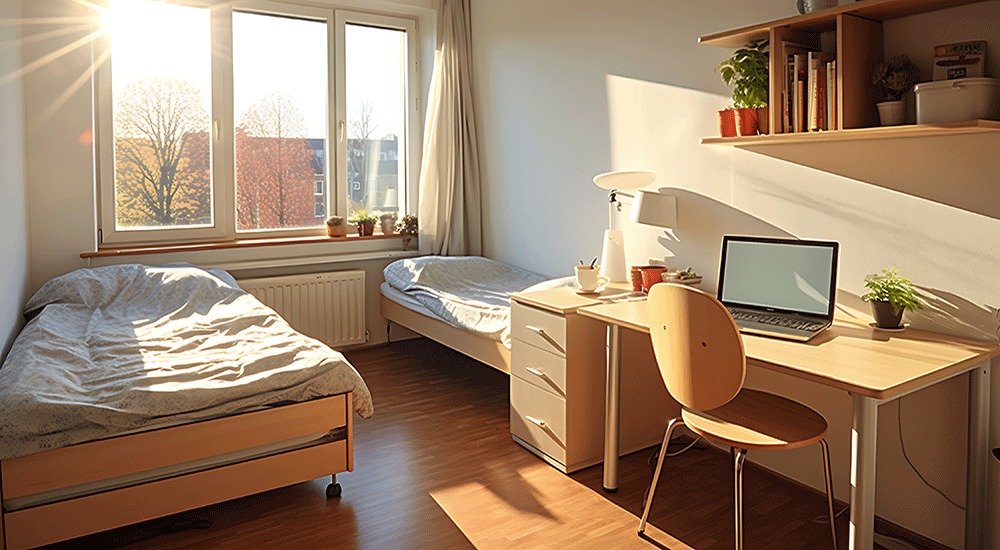Student housing is more than just a place to sleep — it’s the heart of campus life where many memories are made and futures are shaped. Unfortunately, certain safety measures in these spaces can sometimes go overlooked.
Below, we’ll go over how — by investing in security doors and windows designed to resist forced entry measures — institutions can enhance student safety, reduce risks, and foster a sense of security for residents and their loved ones.
The Role of Security Doors and Windows in Student Safety
Student housing facilities are dynamic environments with constant foot traffic and the potential for unauthorized access. Security doors and windows act as the first line of defense against break-ins and other threats. Their durability and forced-entry resistance provide an invaluable safeguard, deterring potential intruders while protecting residents and their belongings.
RELATED: Achieving Code-Compliant School Security with Fire-Rated and Forced-Entry Resistant Glass
Impact-resistant and forced-entry-resistant doors and windows are built to endure significant force without compromising their structural integrity. For example, bulletproof glass is a popular choice for student housing windows, as it is designed to withstand high levels of impact and also resists shattering upon contact. Such features are critical in preventing break-ins and creating a safer living environment.
Additionally, security doors often include advanced locking mechanisms and reinforced frames. These features go beyond traditional residential doors, offering enhanced protection that can withstand both physical attacks and attempts to tamper with locking systems. When coupled with high-quality windows, these security measures create a formidable barrier against threats, giving students and staff peace of mind.
Why Impact-Resistant Products Matter in Dorm Security
Impact-resistant doors and windows are engineered to provide resilience in the face of various threats, including attempted forced entry, severe weather and even vandalism. For student housing, this resilience is important for several reasons:
- Deterring Crime: The robust construction of these products makes them difficult to breach, deterring opportunistic criminals from targeting student residences.
- Protecting Valuables: Many students bring valuable personal items — including electronics and expensive school supplies — to their dormitories. Secure doors and windows help protect these belongings.
- Enhancing Campus Reputation: Institutions that prioritize safety are more likely to attract students and parents who value a secure living environment.
Mitigating Risks Through Advanced Security
Security doors and windows in student housing aren’t just physical barriers — they’re a strategy for risk mitigation. By reducing the likelihood of unauthorized access, institutions can significantly lower the risk of incidents that could lead to legal liabilities or damage to their reputation.
RELATED: Dorm Security Standards Are Too Low, Keycards Are at the Heart of the Problem
For instance, a housing facility equipped with impact-resistant products is better prepared to handle emergency situations, such as attempted break-ins during holidays or late-night disturbances. These measures also align with broader campus safety protocols to create a comprehensive safety network.
The integration of security doors and windows into housing facilities also contributes to a culture of safety, reducing anxiety and enabling students to focus on their studies and personal growth.
Choosing the Right Security Solutions
When selecting security doors and windows for student housing, institutions must prioritize quality and proven performance. Key considerations include:
- Material Durability: Products made from reinforced steel, aluminum or advanced composites provide long-lasting protection.
- Impact Resistance: Windows with bulletproof glass and doors with impact-rated cores are essential for high-risk areas.
- Aesthetics: Security features should seamlessly integrate with the building’s design to avoid creating a fortress-like appearance.
- Compliance with Standards: Products should meet or exceed relevant safety and building code requirements.
Collaborating with trusted manufacturers and installers is essential to achieving these goals. Institutions should work with experts who specialize in impact-resistant and forced-entry-resistant products to guarantee optimal performance and a secure installation.
Beyond the Physical Barriers
While security doors and windows provide a vital layer of defense, they are most effective when integrated into a broader safety plan. This includes:
- Regular maintenance and inspections to identify potential vulnerabilities
- Thorough training for campus staff and residents on safety protocols
- Leveraging technology — such as access control systems and surveillance cameras — to monitor and manage entry points
A holistic approach to campus safety doesn’t just strengthen physical security, it reinforces the institution’s commitment to student well-being.
Creating a Secure Future for Student Housing
As campus safety continues to evolve, the importance of security doors and windows cannot be overstated. By investing in impact-resistant and forced-entry-resistant products, institutions can create a safer living environment that protects students and enhances overall campus safety. Such measures are not just an investment in physical infrastructure — they represent a commitment to the safety and success of every student.
Brian Hanson is the Marketing Director for Specialty Fenestration Group, a consortium of leading manufacturers specializing in advanced fenestration solutions, including the Quikserv and U.S. Bullet Proofing brands.
NOTE: The views expressed by guest bloggers and contributors are those of the authors and do not necessarily represent the views of, and should not be attributed to, Campus Safety.







